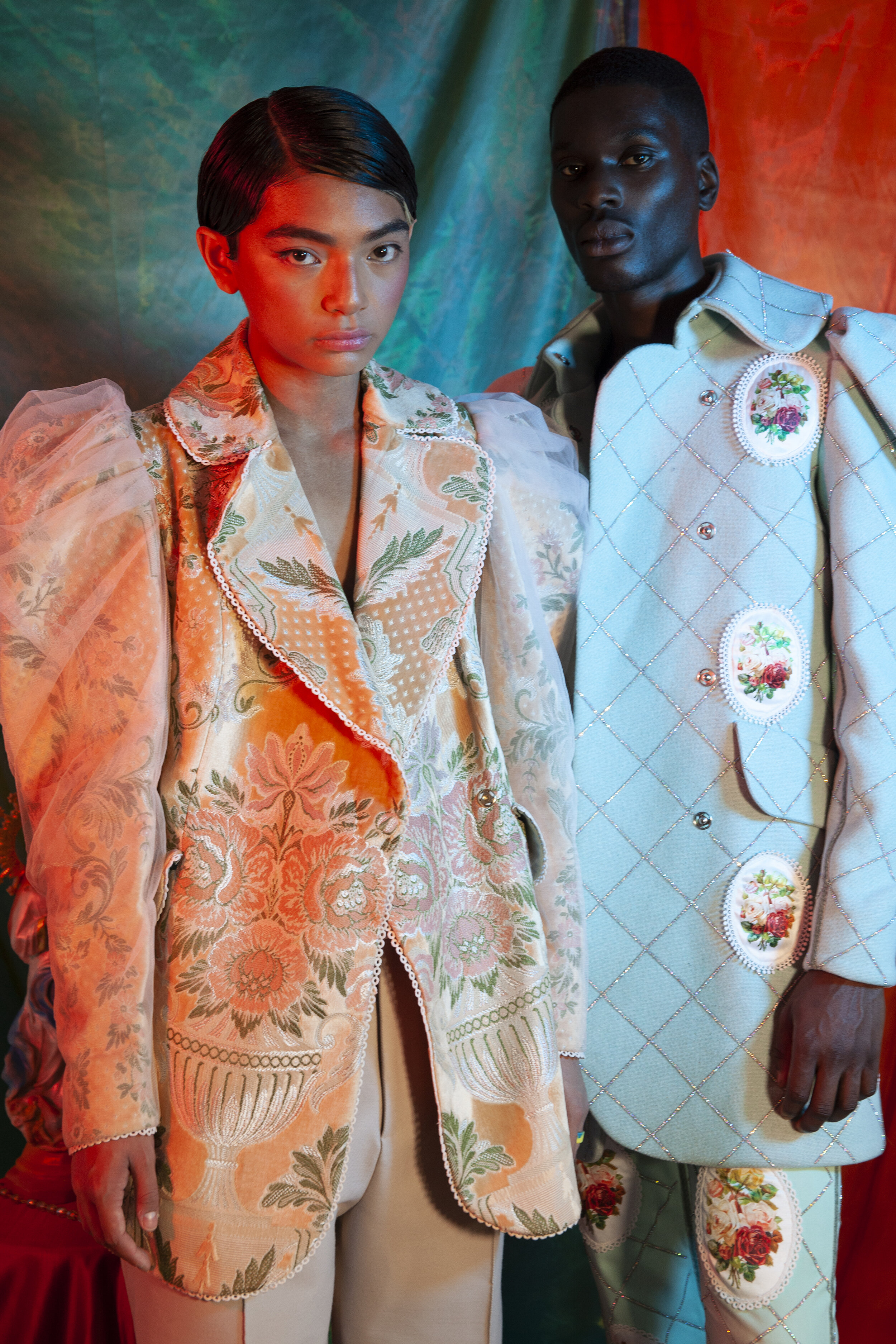An ode to the Santacruzan | DSTNGR Editorial
Music is playing by a marching band, whilst people in our baranggay (community) gather holding flowers, candles and arcs stating the names of queens I have never heard of before. My female cousins and I are given small bouquets to hold, as we line up together with other girls in pretty gowns similar to our own. Loud drums continue to play as we proceed to parade around the village… At just 5 years of age, this is my earliest memory of a Santacruzan parade.
Model I wears Gown by VINCENT Lapp and Earrings by Wai Yan Choi Jewellery | Model II wears Suit by MMRMS Studio, Face Crown by Wai Yan Choi Jewellery, Necklace by Feather Pendants Jewellery and Boots by ASOS
Being Filipino, attending a Santacruzan parade has been part of our long list of traditions. Every year during the month of May, wherever you are in the country there will be a Santacruzan celebration going on. Beautiful women and dressed up girls, parade around the streets holding either a bouquet of flowers or a crucifix. Santacruzan is very much the highlight for the month of May or for Catholics, the month of the Blessed Virgin Mary. Following the proclamation of the Immaculate Concepcion dogma, Catholics dedicated the month of May to honor the Blessed Virgin Mary. This religious custom became a tradition known today as ‘Flores de Mayo’ (Flowers of May) and also the ‘Queen of Philippine Festivals.’ It’s the most prominent festival in the country celebrated not just in one province but nationwide, beginning with a nine-day novena and culminates in parades, which we call the Santacruzan.
Beginning in 1854, during the Spanish colonization in the Philippines - the Spaniards introduced Santacruzan to Filipinos, as a means to further integrate the Catholic religion into the Filipino way of life. The religious-historical parade is held in honor of Queen Helena of Constantinople and her son Constantine the Great, on their findings of the True Cross: the cross that’s said to be the one Jesus was crucified. According to legend, the 75 year-old Queen found a total of three crosses during her expedition to the sight of the Crucifixion. In order for her to determine which one was the True Cross, she ordered an ill servant to lie down on each of the three crosses, with the one healing the servant deemed as the True Cross.
To convince Filipinos to accept and embrace Catholicism, the Santacruzan was devised by the Church to relay stories from the Bible in the form of a procession. Instead of statues parading the streets, actual people specifically women would parade and portray the following characters; Reyna Fe carries a cross representing the virtue of faith. Reyna Esperanza carries an anchor representing hope. Reyna Caridad carries a red heart representing charity. Divina Pastora holds a shepherd’s staff and Rosa Mistica carries a bouquet of roses. Reyna de las Flores or the Queen of Flores de Mayo, carries a bouquet of flowers. Reyna Emperatiz is a representation of Queen Helena’s ‘Augusta’ title, meaning Empress or Queen Mother - a title given by Constantinople. Lastly Reyna Elena, the personification of St. Helena and often portrayed by one of the most beautiful maidens within the community. A small boy dressed as Constantine, would also accompany this character. Traditionally, the people of the community choose young women to parade as these Biblical characters, wearing stunning yet conservative gowns — preferably a traditional Mestiza style dress.
Although the Santacruzan is a celebration of the Blessed Virgin Mary, it is also a celebration of Filipina beauty and women. Beautiful women believed to possess qualities of the Blessed Virgin Mary, are chosen to participate and parade around the streets wearing glamorous Maria Clara dresses, whilst the community admire and appreciate their grace, beauty and reflection of the Blessed Virgin Mary. Some communities hold competitions among the participants and others even invite known female celebrities and beauty queens, to participate in their parade. In short, the Santacruzan is slowly becoming a beauty pageant, which Filipinos love and adore.
There are now communities in the Philippines that have LGBQT members participate in their Santacruzan festivities. Gay men and transgender women would dress up and parade the streets with pride, wearing elegant Maria Clara’s or dresses they designed and made themselves to express their own creativity. While the participation of the LGBQT community in the Santacruzan has always been evident through the decorations and designer gowns, their participation as the Biblical characters is quite different from tradition, especially to the Catholic Church. While there is a good number of Church members who respect and accept the LGBQT community, times have progressed through the years, yet not entirely. Certain members still do not fully accept and believe in LGBQT rights such as marriage or choice of gender orientation.
Model I wears Jacket by ANA LJUBINKOVIC, Trousers by Petja Zorec, Glasses by Wai Yan Choi Jewellery and Shoes by Hugo Boss | Model II wears Jacket and Trousers by ANA LJUBINKOVIC and shoes by Hugo Boss
In the city of Marikina, a local LGBQT group decided to host their own version of the Santacruzan parade. Started in 1971, the group grew overtime and is still celebrated today. Gay nightclubs such as Nectar in Manila, Philippines, have their own way of celebrating Flores de Mayo with their own version of the Santacruzan by means of a drag race. Transgender women have also been present and accepted to participate in the Santacruzan parade, portraying Biblical characters.
Model I wears Playsuit by VINCENT Lapp and Boots by MALAN BRETON | Model II wears Traditional Filipino Barong (from the Philippines), Trousers by Petja Zorec and Shoes by Hugo Boss
As time goes by, the way we Filipinos celebrate our traditions will continue to change however, this does not mean we will forget the very essence of why we celebrate these festivities and traditions. As for the Flores de Mayo Festival and the Santacruzan, Filipinos and Catholics celebrate in honor of the Blessed Virgin Mary and the True Cross of Christ our Savior. The Santacruzan is more than a commemoration of the True Cross, it’s where the Filipino community come together. From organising the festivities and the parades, to witnessing the results of the preparations and hard work — it is also a celebration of the Filipino community. Looking back at all the Santacruzan parades I’ve attended, what I love the most about celebrating these festivities are not the extravagant gowns or the celebrities I’ve seen portray Biblical characters — but in the way people of the community unite as one. No one is alienated, everyone in the community is included and celebrated. The festivity is one big family.
After all, like the True Cross of Christ found by Queen Helena; it is for everyone and will always be for everyone.
CREDITS
Photographer - Aynrand Cosette Ariel
Photographer Assistant - Sophie Randle
Stylist - Jeff Maranon
Assistant Stylist - Nkemdilim Ezenekwe
MUA - Tahiyah Ali
Hair Stylist - Maeve McElholm
Models - Mikee Cayanan + Haruna Jebak
Special thanks to Smith Town Studios








